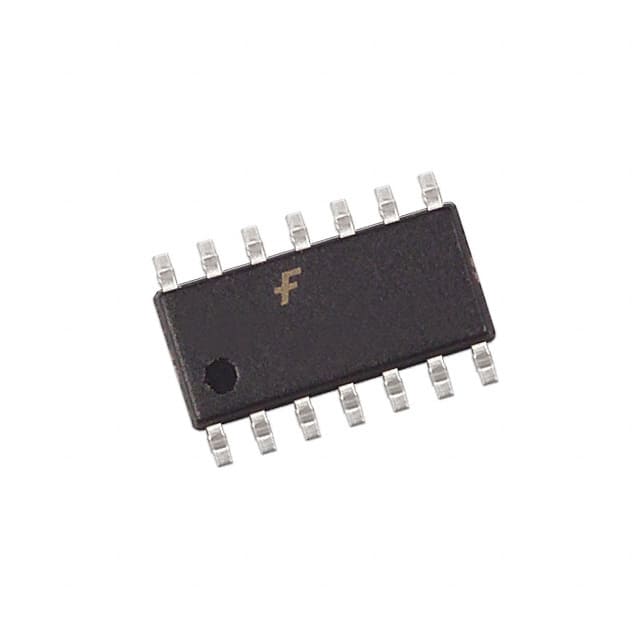Voir les spécifications pour les détails du produit.

MM74HCT164SJ
Product Overview
- Category: Integrated Circuit
- Use: Shift Register
- Characteristics: High-Speed, CMOS Logic, 8-Bit Serial-In/Parallel-Out
- Package: SOIC (Small Outline Integrated Circuit)
- Essence: Serial-to-Parallel Data Conversion
- Packaging/Quantity: Tape and Reel, 2500 units per reel
Specifications
- Supply Voltage Range: 2V to 6V
- Input Voltage Range: 0V to VCC
- Output Voltage Range: 0V to VCC
- Maximum Clock Frequency: 25 MHz
- Maximum Propagation Delay: 20 ns
- Operating Temperature Range: -40°C to +85°C
Detailed Pin Configuration
The MM74HCT164SJ has a total of 14 pins. The pin configuration is as follows:
- GND (Ground)
- SER (Serial Data Input)
- QA (Parallel Output A)
- QB (Parallel Output B)
- QC (Parallel Output C)
- QD (Parallel Output D)
- QE (Parallel Output E)
- QF (Parallel Output F)
- QG (Parallel Output G)
- QH (Parallel Output H)
- MR (Master Reset)
- CP (Clock Pulse Input)
- DS (Serial Data Input)
- VCC (Supply Voltage)
Functional Features
- High-speed operation allows for efficient data transfer.
- CMOS logic ensures low power consumption.
- 8-bit serial-in/parallel-out functionality enables easy conversion between serial and parallel data formats.
- Master reset (MR) input allows for clearing the register to its initial state.
- Clock pulse (CP) input controls the shifting of data from the serial input to the parallel outputs.
Advantages and Disadvantages
Advantages: - High-speed operation enables quick data processing. - CMOS logic ensures low power consumption, making it suitable for battery-powered devices. - Compact SOIC package allows for easy integration into electronic circuits.
Disadvantages: - Limited number of parallel outputs (8 bits). - Requires an external clock signal for proper operation.
Working Principles
The MM74HCT164SJ is a shift register that converts serial data input into parallel output. It operates based on the clock pulse provided at the CP pin. When the clock pulse rises, the data at the serial input (SER) is shifted into the register. On each rising edge of the clock pulse, the data shifts one position to the right. The parallel outputs (QA-QH) reflect the current state of the register. The master reset (MR) input can be used to clear the register to its initial state.
Detailed Application Field Plans
The MM74HCT164SJ is commonly used in various applications, including:
Serial-to-Parallel Data Conversion: It is widely used to convert serial data streams into parallel formats, allowing for easier processing and manipulation of data.
LED Matrix Control: The shift register's parallel outputs can be connected to drive LEDs in a matrix configuration, enabling control of multiple LEDs using fewer microcontroller pins.
Digital Displays: It can be utilized to drive 7-segment displays or other digital display modules, simplifying the interface between the microcontroller and the display.
Data Storage: The shift register can be employed as a temporary storage device for data buffering or as part of a larger memory system.
Detailed and Complete Alternative Models
Some alternative models to the MM74HCT164SJ include:
SN74HC164N: This is a similar 8-bit serial-in/parallel-out shift register from Texas Instruments. It operates at a maximum clock frequency of 50 MHz and is available in a DIP (Dual Inline Package) format.
CD74HC164E: Another 8-bit shift register from Texas Instruments, offering similar functionality to the MM74HCT164SJ. It operates at a maximum clock frequency of 50 MHz and comes in a PDIP (Plastic Dual Inline Package).
74HC164D: This shift register from NXP Semiconductors also provides 8-bit serial-in/parallel-out conversion. It operates at a maximum clock frequency of 80 MHz and is available in an SOIC package.
These alternative models offer similar functionality and can be used as replacements for the MM74HCT164SJ depending on specific requirements and availability.
Word count: 529 words
Énumérez 10 questions et réponses courantes liées à l'application de MM74HCT164SJ dans les solutions techniques
Sure! Here are 10 common questions and answers related to the application of MM74HCT164SJ in technical solutions:
Q: What is MM74HCT164SJ? A: MM74HCT164SJ is a high-speed CMOS 8-bit serial-in, parallel-out shift register IC.
Q: What is the purpose of MM74HCT164SJ? A: It is used for serial-to-parallel data conversion, allowing you to input data serially and output it in parallel format.
Q: What is the maximum clock frequency supported by MM74HCT164SJ? A: The maximum clock frequency supported is typically around 25 MHz.
Q: Can MM74HCT164SJ be cascaded to increase the number of outputs? A: Yes, multiple MM74HCT164SJ ICs can be cascaded together to increase the number of outputs.
Q: What is the power supply voltage range for MM74HCT164SJ? A: The power supply voltage range is typically between 2V and 6V.
Q: Does MM74HCT164SJ have built-in protection against electrostatic discharge (ESD)? A: Yes, MM74HCT164SJ has built-in ESD protection to prevent damage from static electricity.
Q: Can MM74HCT164SJ operate in both TTL and CMOS logic levels? A: Yes, MM74HCT164SJ is compatible with both TTL and CMOS logic levels.
Q: What is the typical output current capability of MM74HCT164SJ? A: The typical output current capability is around 4 mA.
Q: Can MM74HCT164SJ be used in applications requiring bidirectional data transfer? A: No, MM74HCT164SJ is a unidirectional shift register and does not support bidirectional data transfer.
Q: What are some common applications of MM74HCT164SJ? A: MM74HCT164SJ is commonly used in applications such as LED displays, serial-to-parallel data conversion, and general-purpose digital logic circuits.
Please note that the answers provided here are general and may vary depending on specific datasheet specifications and application requirements.

